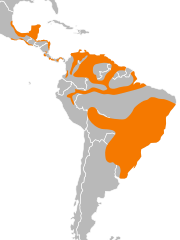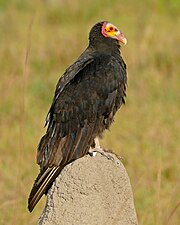Superregnum: Eukaryota
Cladus: Unikonta
Cladus: Opisthokonta
Cladus: Holozoa
Regnum: Animalia
Subregnum: Eumetazoa
Cladus: Bilateria
Cladus: Nephrozoa
Superphylum: Deuterostomia
Phylum: Chordata
Subphylum: Vertebrata
Infraphylum: Gnathostomata
Megaclassis: Osteichthyes
Cladus: Sarcopterygii
Cladus: Rhipidistia
Cladus: Tetrapodomorpha
Cladus: Eotetrapodiformes
Cladus: Elpistostegalia
Superclassis: Tetrapoda
Cladus: Reptiliomorpha
Cladus: Amniota
Classis: Reptilia
Cladus: Eureptilia
Cladus: Romeriida
Subclassis: Diapsida
Cladus: Sauria
Infraclassis: Archosauromorpha
Cladus: Crurotarsi
Divisio: Archosauria
Cladus: Avemetatarsalia
Cladus: Ornithodira
Subtaxon: Dinosauromorpha
Cladus: Dinosauriformes
Cladus: Dracohors
Cladus: Dinosauria
Ordo: Saurischia
Cladus: Eusaurischia
Subordo: Theropoda
Cladus: Neotheropoda
Cladus: Averostra
Cladus: Tetanurae
Cladus: Avetheropoda
Cladus: Coelurosauria
Cladus: Tyrannoraptora
Cladus: Maniraptoromorpha
Cladus: Maniraptoriformes
Cladus: Maniraptora
Cladus: Pennaraptora
Cladus: Paraves
Cladus: Eumaniraptora
Cladus: Avialae
Infraclassis: Aves
Cladus: Avebrevicauda
Cladus: Pygostylia
Cladus: Ornithothoraces
Cladus: Ornithuromorpha
Cladus: Carinatae
Parvclassis: Neornithes
Cohors: Neognathae
Cladus: Neoaves
Ordo: Accipitriformes
Familia: Cathartidae
Genus: Cathartes
Species: C. aura – C. burrovianus – C. melambrotus
Name
Cathartes Illiger, 1811: 236
References
Primary references
Illiger, J.K.W. 1811. Prodromus systematis mammalium et avium additis terminis zoographicis utriusque classis, eorumque versione germanica. C. Salfield: Berolini. xviii + 302 pp. BHL Reference page.
Links
IOC
The genus Cathartes includes medium-sized to large carrion-feeding birds in the New World vulture (Cathartidae) family. The three extant species currently classified in this genus occur widely in the Americas. There is one extinct species known from the Quaternary of Cuba.[3]
Cathartes is the Greek word καθαρτής, for "purifier," referring to these vultures' role as "cleansers" that "tidy up" decomposing corpses in nature.
Taxonomy
Description
The first member of this genus to be formally described, the turkey vulture, was named by Linnaeus as Vultur aura in his Systema Naturae in 1758,[4] but was eventually moved to the current genus which had been created by German zoologist Johann Illiger in 1811.[5] The yellow-headed birds first described in 1845 by John Cassin were not split into two species until 1964.[6][7]
Systematics
Cathartes is one of the five genera of New World vultures. The taxonomic placement of these vultures remains unclear.[8] It is the only genus in its family that is not monotypic. The New World and Old World vultures are similar in appearance and have similar ecological roles, but evolved from different ancestors in widely separated parts of the world. The relationships between the two vulture groups is a matter of debate, with some earlier authorities suggesting that the New World vultures are more closely related to storks.[9]
In 2007 the American Ornithologists' Union's North American checklist moved Cathartidae back into the lead position in Falconiformes, but with an asterisk that indicates it is a taxon "that is probably misplaced in the current phylogenetic listing but for which data indicating proper placement are not yet available".[10] The AOU's draft South American checklist places the Cathartidae in their own order, Cathartiformes.[11] However, recent DNA study on the evolutionary relationships between bird groups also suggests that they are related to the other birds of prey and should be part of a new order Accipitriformes instead,[12] a position adopted in 2010 by the AOU's North American check-list,[13] and shared with the International Ornithological Congress.[14]
Species
| Common name | Scientific name and subspecies | Range | Size and ecology | IUCN status and estimated population |
|---|---|---|---|---|
| Turkey vulture
|
Cathartes aura (Linnaeus, 1758)
Five subspecies
|
the Americas from southern Canada to Cape Horn |
Size: Habitat: Diet: |
LC
|
| Lesser yellow-headed vulture
|
Cathartes burrovianus Cassin, 1845 |
Argentina, Belize, Bolivia, Brazil, Chile, Colombia, Costa Rica, Ecuador, El Salvador, French Guiana, Guatemala, Guyana, Honduras, Mexico, Nicaragua, Panama, Paraguay, Peru, Suriname, Uruguay, and Venezuela |
Size: Habitat: Diet: |
LC
|
|---|---|---|---|---|
| Greater yellow-headed vulture
|
Cathartes melambrotus Wetmore, 1964 |
South America |
Size: Habitat: Diet: |
LC
|
One extinct species, Emslie's vulture (C. emsliei) is known from Late Quaternary fossil remains from Cuba, and it likely went extinct following the extinction of the megafauna whose carrion it would have fed on during the Quaternary extinction event, coupled with the subsequent loss of the savanna habitats it would have favored.[19]
Description
Duration: 4 minutes and 18 seconds.4:18
Turkey vultures coming in to the same roost they use for the season.
All Cathartes species have featherless heads with brightly colored skin, yellow to orange in the yellow-headed vultures, bright red in the turkey vulture. All three species share a well-developed sense of smell, which is rare in birds, that enables them to locate carrion under the canopy.
Distribution and habitat
The vultures of Cathartes mosty occupy forests of the Americas, especially Mexico, Central America, and South America.
Ecology and behaviour
While all species obtain most of their diet by scavenging, the lesser yellow-headed vulture is known to hunt live prey in wetland environments.
References
Wikimedia Commons has media related to Cathartes.
Wikispecies has information related to Cathartes.
Vigors, N. A. (1825). "Sketches in Ornithology; or, Observations on the leading Affinities of some of the more extensive groups of Birds. On the Groups of the Vulturidæ". The Zoological Journal. 2 (7): 384.
International Commission on Zoological Nomenclature (1958) [1916]. "Opinion 67. One Hundred and Two Bird Names Placed in the Official List of Generic Names". Opinions and Declarations Rendered by the International Commission on Zoological Nomenclature. 1 (B): 177–182.
Suárez, William; Olson, Storrs L. (2020-09-21). "A new fossil vulture (Cathartidae: Cathartes) from Quaternary asphalt and cave deposits in Cuba". Bulletin of the British Ornithologists' Club. 140 (3): 335–343. doi:10.25226/bboc.v140i3.2020.a6. ISSN 0007-1595.
Linnaeus, Carolus (1758). Systema naturae per regna tria naturae, secundum classes, ordines, genera, species, cum characteribus, differentiis, synonymis, locis. Tomus I. Editio decima, reformata (in Latin). Holmiae. (Laurentii Salvii). p. 86.
Illiger, Johann (1811). Prodromus systematis mammalium et avium. Berolini: Sumptibus C. Salfeld. p. 236.
Cassin, John. "[untitled]". Proceedings of the Academy of Natural Sciences of Philadelphia. 2 (8): 212. "Near Veracruz, Mexico."
Wetmore, Alexander (1964). "A revision of the American vultures of the genus Cathartes". Smithsonian Miscellaneous Collections. 146 (6): 15.
Remsen, J. V. Jr.; C. D. Cadena; A. Jaramillo; M. Nores; J. F. Pacheco; M. B. Robbins; T. S. Schulenberg; F. G. Stiles; D. F. Stotz & K. J. Zimmer (2007) A classification of the bird species of South America. Archived March 2, 2009, at the Wayback Machine South American Classification Committee]
Sibley, Charles G. and Burt L. Monroe (1990) Distribution and Taxonomy of the Birds of the World. Yale University Press. ISBN 0-300-04969-2
American Ornithologists' Union (2009)
Remsen et al. (2008)
Hackett et al. (2008)
American Ornithologists' Union (2010)
International Ornithological Congress. "IOC World Bird List". 14.1. IOC. Retrieved 25 January 2024.
"Cathartes". Integrated Taxonomic Information System. Retrieved 15 May 2011.
Sauer, J. R., J. E. Hines, J. E. Fallon, K. L. Pardieck Jr. Ziolkowski, D. J. and W. A. Link. The North American Breeding Bird Survey, results and analysis 1966-2013 (Version 1.30.15). USGS Patuxent Wildlife Research Center (2014b). Available from http://www.mbr-pwrc.usgs.gov/bbs/ Archived 2012-06-09 at the Wayback Machine
BirdLife International (2021). "Cathartes burrovianus". IUCN Red List of Threatened Species. 2021: e.T22697630A163511443. doi:10.2305/iucn.uk.2021-3.rlts.t22697630a163511443.en.
BirdLife International (2024). "Greater Yellow-headed Vulture Cathartes melambrotus". BLI Datazone.
Suárez, William; Olson, Storrs L. (September 2020). "A new fossil vulture (Cathartidae: Cathartes) from Quaternary asphalt and cave deposits in Cuba". Bulletin of the British Ornithologists' Club. 140 (3): 335–343. doi:10.25226/bboc.v140i3.2020.a6. ISSN 0007-1595.
Retrieved from "http://en.wikipedia.org/"
All text is available under the terms of the GNU Free Documentation License




